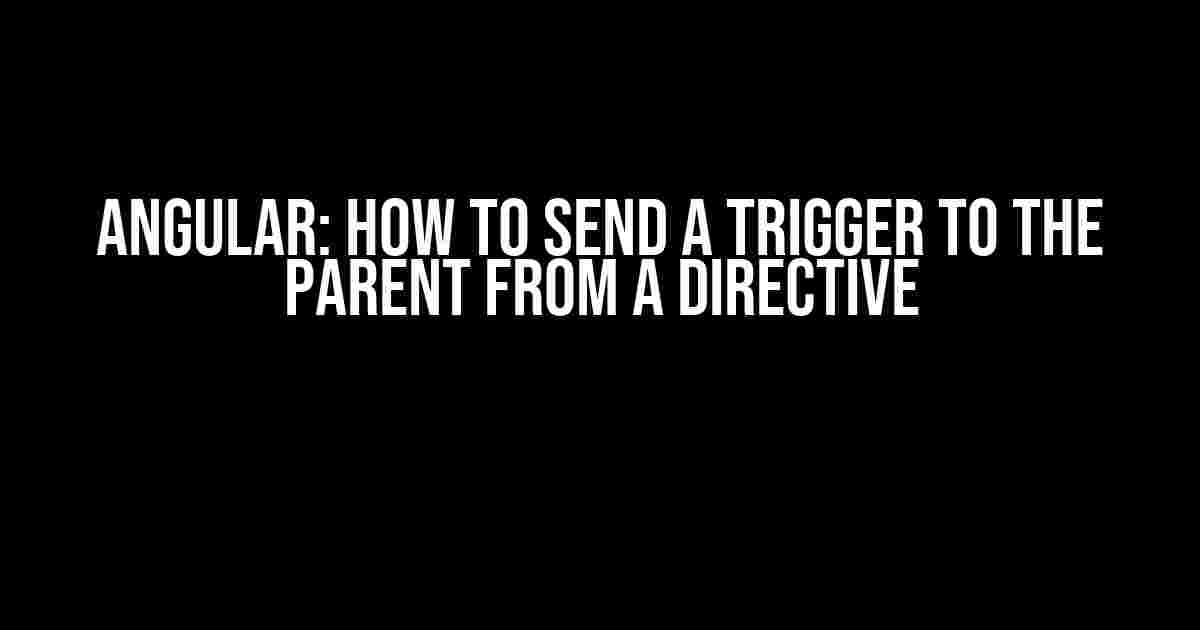Here is the article:
In Angular, communicating between components and directives can be a bit tricky. One common scenario is when you need to send a trigger from a directive to its parent component. This can be achieved using a combination of Angular’s built-in mechanisms. In this article, we will explore how to send a trigger to the parent from a directive.
Using Output Emitter
// my.directive.ts
import { Directive, Output, EventEmitter } from '@angular/core';
@Directive({
selector: '[myDirective]'
})
export class MyDirective {
@Output() onTrigger = new EventEmitter();
triggerParent() {
this.onTrigger.emit();
}
}
In the above code, we’ve created a directive with an output emitter `onTrigger`. The `triggerParent` function emits an event when called, which can be caught by the parent component.
Catching the Event in the Parent Component
To catch the event emitted by the directive, you need to add a template variable to the element that hosts the directive. Here’s an example:
// parent.component.html
<div myDirective (onTrigger)="handleTrigger()"></div>
// parent.component.ts
import { Component } from '@angular/core';
@Component({
selector: 'app-parent',
templateUrl: './parent.component.html',
styleUrls: ['./parent.component.css']
})
export class ParentComponent {
handleTrigger() {
console.log('Trigger received from directive!');
}
}
In the above code, we’ve added a template variable `(onTrigger)=”handleTrigger()”` to the element that hosts the directive. When the directive emits an event, the `handleTrigger` function will be called in the parent component.
Conclusion
In this article, we’ve seen how to send a trigger from a directive to its parent component using an output emitter. This technique allows you to decouple the directive from its parent and enable communication between them. By using this approach, you can create reusable and modular directives that can be used throughout your Angular application.
Remember to always follow best practices and keep your code organized, and you’ll be sending triggers like a pro in no time!
Here are 5 Questions and Answers about “Angular: How to send a trigger to the parent from a directive” with a creative voice and tone:
Frequently Asked Question
Get answers to your most pressing questions about sending triggers to parents from directives in Angular!
Q1: What’s the big deal about sending triggers to parents from directives?
Sending triggers to parents from directives is crucial in Angular because it allows your directives to communicate with their parent components, enabling a more cohesive and interactive user experience. Think of it like a well-orchestrated dance between your directive and its parent!
Q2: How do I send a trigger to the parent from a directive using Output and EventEmitter?
Easy peasy! In your directive, declare an Output property and an EventEmitter. Then, when you want to send the trigger, emit the event using the EventEmitter. In your parent component, use the directive’s selector and bind the output event to a method that’ll handle the trigger. Boom! Communication established!
Q3: Can I use a service to send triggers to the parent from a directive?
Absolutely! Using a service is another way to send triggers to the parent from a directive. You can inject the service into both your directive and parent component, and then use the service to emit events or send notifications. This approach is especially useful when you need to communicate between multiple components.
Q4: How do I send data with the trigger from the directive to the parent?
When emitting the event, you can pass data as an argument to the EventEmitter’s emit method. Then, in your parent component, access the data in the event handler method. You can also use a service to share data between the directive and parent component.
Q5: Are there any best practices for sending triggers from directives to parents in Angular?
Yes! Follow the principles of loose coupling and separation of concerns. Keep your directive and parent component independent, and use a clear and descriptive naming convention for your output events and methods. This will make your code more maintainable and easier to understand.

